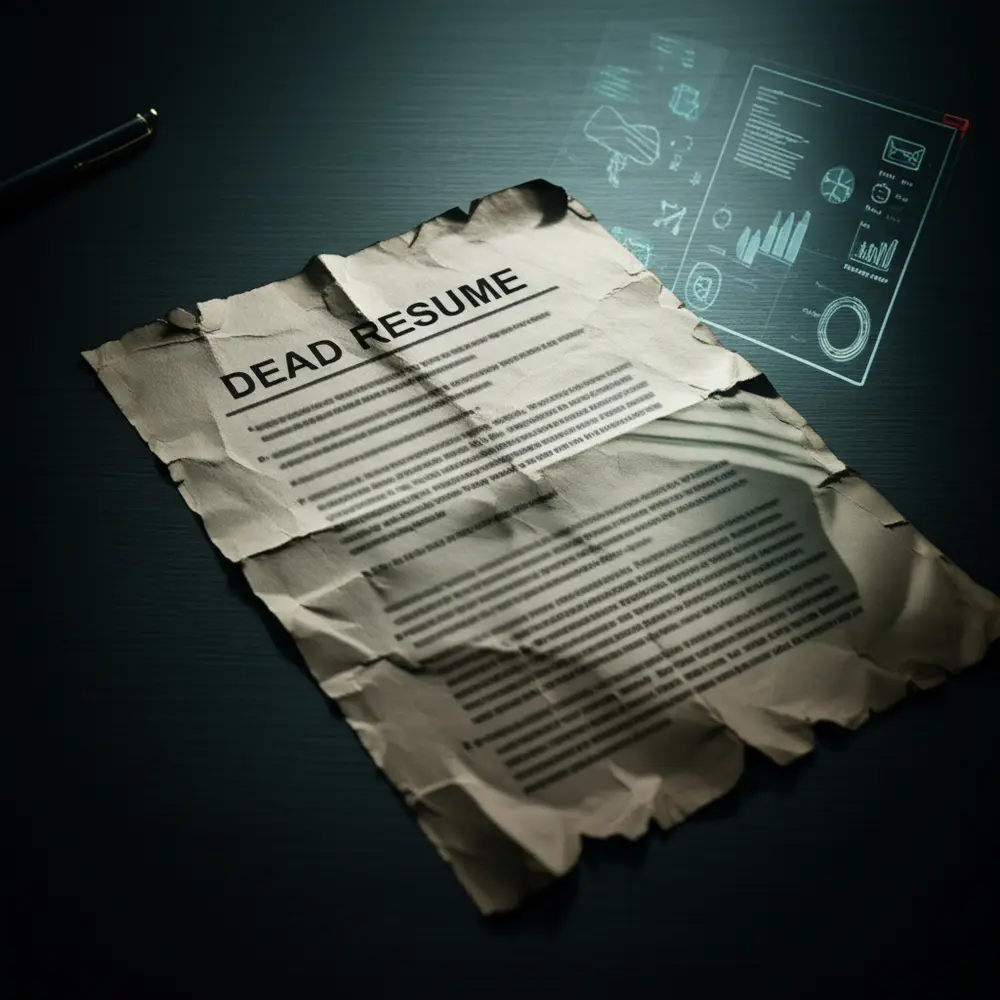Are you grappling with mounting recruitment costs and high employee turnover? The frustration of sifting through countless resumes, only to find a mismatch, wastes valuable time and resources. You know the pain of crucial roles remaining unfilled, directly impacting your team’s productivity and bottom line.
The traditional resume, once your go-to, now often acts as a roadblock. It frequently fails to reveal a candidate’s true capabilities, adaptability, or problem-solving skills, leaving you with incomplete insights. This outdated approach keeps you from securing the top talent you desperately need to drive your business forward.
It’s time you embraced a hiring strategy that addresses these critical challenges head-on. You need to move beyond static documents and leverage modern HR trends that unlock genuine potential, ensuring every hire contributes meaningfully to your organization’s success.
The Peril of the “Dead Resume”: Why Traditional Methods Fail You
The concept of a “dead resume” reflects a critical shift in modern talent acquisition. You can no longer rely on traditional resumes to provide a comprehensive view of a candidate’s true capabilities. They are static documents in a dynamic professional landscape, often presenting an incomplete picture of potential.
Consequently, these outdated formats frequently fail to capture essential soft skills. You overlook adaptability, problem-solving abilities, and crucial growth mindsets vital for today’s complex roles. An emphasis on past job titles misses the continuous learning required for innovation.
A major contributor to this crisis is your reliance on conventional screening tools. Applicant Tracking Systems (ATS), while efficient for volume, frequently filter out highly qualified individuals based purely on keyword matching. This narrow focus hinders your discovery of valuable, diverse talent.
Furthermore, traditional hiring strategy often suffers from inherent biases embedded in resume review. You may subconsciously favor certain backgrounds or career paths, leading to overlooked diversity. This ultimately stifles innovation potential within your talent pool.
The time-consuming nature of sifting through countless resumes also drains your HR resources. This inefficient process diverts your attention from more strategic tasks. It ultimately delays critical hires and impacts departmental productivity and growth.
ATS Keyword Matching vs. Human Insight: Bridging the Gap
You face a dilemma between the efficiency of ATS and the nuance of human judgment. ATS excels at initial filtering, rapidly processing vast numbers of applications. However, it often misses candidates whose experiences don’t perfectly align with predefined keywords.
Human insight, on the other hand, allows you to identify transferable skills and unconventional experiences. You can recognize potential even when a resume doesn’t fit a rigid template. This deep understanding uncovers valuable talent often missed by automated systems.
The most effective strategy combines both. You use ATS for initial high-volume screening, then apply structured human review for promising candidates. This hybrid approach ensures you capture both efficiency and depth in your talent acquisition process.
Case Study: Logistics Express Revamps Hiring
Logistics Express, a national delivery service, faced 30% employee turnover among new hires within their first year. Their traditional resume-based hiring, heavily reliant on ATS, was failing. They identified a critical need to better assess candidates’ problem-solving and adaptability.
You introduced a two-stage assessment process after initial ATS screening. Candidates completed a situational judgment test simulating delivery challenges and a short video interview assessing their communication skills. This move revealed deeper insights into candidate potential.
The results were significant: Logistics Express reduced new hire turnover by 18% in six months. They also reported a 15% increase in team morale among new hires. You helped them build a more resilient workforce, directly impacting their operational efficiency.
Data Security and LGPD in Candidate Information
You must prioritize data security for all candidate information. Collecting, storing, and processing personal data carries significant responsibility. You need robust systems to protect against breaches and unauthorized access, maintaining candidate trust.
Compliance with the General Data Protection Law (LGPD) is not optional; it is essential. You must ensure transparent data collection practices. This includes informing candidates about how their data will be used and securing explicit consent when necessary. Utilizing official communication channels helps maintain compliance and trust.
The LGPD also grants candidates rights, such as access to their data and the right to erasure. You must establish clear procedures for handling these requests. This demonstrates your commitment to ethical data management and builds trust.
You implement end-to-end encryption for all stored resumes and assessment results. Access controls are strictly enforced, limiting who can view sensitive information. Regular security audits help you identify and rectify potential vulnerabilities promptly.
Failing to comply with LGPD can result in severe fines and reputational damage. You need to invest in secure infrastructure and train your HR team on best practices. Protecting candidate data is as crucial as identifying top talent itself.
Crafting Your Next-Gen Hiring Playbook: Beyond Credentials
You must develop a forward-thinking hiring strategy imperative for today’s competitive market. This means actively seeking candidates who align with company culture and possess adaptable skills. You move beyond merely checking off resume boxes.
The focus has decisively shifted from academic pedigrees and work history to demonstrable skills and capabilities. You now prioritize what candidates can *do* over where they have *been*. This competency-based approach significantly broadens your talent pools.
Furthermore, skills-based hiring directly addresses the limitations of a “dead resume.” You can identify potential in diverse candidates who may not have followed conventional career paths. These individuals possess valuable, transferable skills crucial for future roles.
A truly effective talent acquisition framework involves your continuous evaluation and adaptation of recruitment practices. Moving beyond the limitations of the “dead resume” allows you to unlock a broader, more diverse pool of qualified professionals. This secures your future growth and competitive advantage.
Therefore, you must discard the notion of a “dead resume” and embrace these evolving HR trends. This is not optional; it is fundamental for building resilient, future-ready organizations. You can now attract and secure the best talent available.
Traditional Interviews vs. Behavioral Assessments: Unlocking True Potential
You might traditionally rely on unstructured interviews, which often lead to inconsistent evaluations. These conversations can be subjective, allowing biases to influence your decisions. You risk missing crucial insights into a candidate’s actual capabilities.
Behavioral assessments, in contrast, provide a structured and objective approach. You ask candidates to describe past situations, actions they took, and results achieved. This method helps you predict future performance more accurately.
For example, instead of asking “Are you a team player?” you ask “Describe a time you collaborated on a challenging project. What was your role, and what was the outcome?” This reveals concrete evidence of their skills.
Behavioral assessments delve into a candidate’s problem-solving style, adaptability, and communication skills. You gain deeper, actionable insights that traditional interviews often overlook. This approach allows you to make more informed hiring decisions.
By integrating behavioral assessments, you standardize your evaluation process and reduce unconscious bias. You ensure a fairer comparison between candidates, ultimately identifying those with the strongest fit for your organizational culture and demands.
Step-by-Step to Implement Skills-Based Hiring:
- Define Core Competencies: You identify the essential skills, both hard and soft, required for the role. This goes beyond job descriptions to focus on actual performance indicators.
- Develop Assessment Methods: You create or select tools like technical tests, case studies, or simulations. These directly measure the defined competencies, offering practical insight.
- Structure Interviews: You design interview questions around specific behavioral scenarios. Each question aims to elicit examples of past behavior demonstrating key skills.
- Implement Portfolio Reviews: For creative or technical roles, you encourage candidates to submit portfolios. These showcase their actual work and project contributions.
- Train Your Team: You ensure all hiring managers and interviewers understand the new methodology. Consistency in evaluation is crucial for fairness and effectiveness.
Case Study: InnovateTech Solutions Boosts Engineering Hires
InnovateTech Solutions, a software development firm, struggled with a 40% mis-hire rate for senior engineers. Traditional resumes highlighted impressive credentials, but new hires often lacked specific problem-solving skills crucial for complex projects. You recognized the “dead resume” problem.
You implemented a skills-based hiring process. After initial screening, candidates completed a take-home coding challenge directly relevant to InnovateTech’s projects. This was followed by a technical presentation to a panel of senior engineers.
The results were transformative: The mis-hire rate plummeted by 25% within nine months. InnovateTech reported a 20% increase in project completion efficiency. You helped them build a high-performing engineering team by focusing on demonstrable skills.
Leveraging Technology for Agile Talent Acquisition
Technology plays a pivotal role in redefining your hiring strategy. AI-powered tools for sourcing, assessment, and interview scheduling streamline processes. This allows your recruiters to focus on strategic interactions rather than repetitive tasks.
AI assists in creating more equitable hiring processes by anonymizing profiles or highlighting skills over background. Furthermore, AI can personalize candidate experiences, making the application journey more engaging and efficient. This builds a positive employer brand.
AI also supports your modern hiring strategy by analyzing interview transcripts for sentiment or identifying candidates with specific, in-demand skills. It truly helps you unearth potential beyond the confines of a “dead resume.”
Collaborative communication platforms are also crucial for recruitment teams. Tools like an omnichannel service platform enable seamless internal coordination. This ensures all team members are aligned on candidate progress and feedback, fostering unprecedented efficiency.
By leveraging these advancements, you reduce time-to-hire significantly, often by 15-20%. This agility allows you to secure top talent faster than competitors. You gain a crucial advantage in today’s rapid market.
Manual Communication vs. Collaborative Platforms: Enhancing Engagement
You understand the challenges of manual communication in recruitment. Individual emails, disjointed phone calls, and scattered notes create inconsistencies. This leads to a fragmented candidate experience and potential miscommunication within your hiring team.
Collaborative platforms revolutionize this process. You centralize all candidate interactions and team discussions in one place. Everyone on your hiring team accesses the same information, ensuring consistent messaging and streamlined workflows.
For instance, imagine using a platform like Multi-User WhatsApp. Your entire HR team can manage candidate communications, answer queries, and share updates in real-time. This eliminates silos and ensures prompt, coordinated responses to every applicant.
This efficiency extends to internal approvals and feedback. You can easily tag team members, request input on candidate profiles, or get quick decisions. This drastically reduces delays often associated with traditional, sequential communication methods.
Ultimately, collaborative platforms enhance the candidate experience by providing timely, personalized engagement. You project a professional and organized image, making your organization more attractive to top talent. This significantly improves your conversion rates.
Case Study: GlobalConnect Services Streamlines Candidate Outreach
GlobalConnect Services, an international consulting firm, faced challenges in candidate engagement. Their manual email and phone outreach resulted in a 35% candidate drop-off rate between initial contact and the first interview. Solutions that streamline candidate outreach were critically needed.
You implemented a Multi-User WhatsApp solution for their recruitment team. This allowed recruiters to send personalized updates, answer FAQs, and schedule follow-ups through a centralized platform. Candidates received consistent, timely communication.
Within four months, GlobalConnect Services saw their candidate drop-off rate decrease by 22%. They also reported a 15% improvement in their Net Promoter Score (NPS) from candidates. You helped them create a more engaging and efficient candidate journey.
The Importance of Support for New HR Technology
You know that implementing new technology is only half the battle. Robust support is essential for maximizing your investment in HR tech. Without it, you risk frustration, underutilization, and a failure to achieve desired outcomes.
High-quality support provides timely assistance for technical issues and guides your team through new features. You need a responsive team that understands your specific HR workflows. This ensures smooth adoption and continuous operation.
Effective support also includes ongoing training and resources. You empower your HR staff to fully leverage the new tools. This reduces the learning curve and boosts confidence in using advanced recruitment technologies effectively.
Consider the potential costs of inadequate support: extended downtime, incorrect data processing, or missed hiring opportunities. You need a reliable partner to troubleshoot promptly. This minimizes disruptions to your critical talent acquisition process.
Ultimately, strong technical support enhances your return on investment (ROI) in HR technology. You ensure your team can focus on strategic tasks. You gain confidence that your tools are always performing at their peak efficiency.
Driving Growth Through Data-Driven Talent Acquisition
Effective HR trends are increasingly data-driven. Analyzing metrics related to sourcing channels, candidate drop-off rates, and interview conversion helps you refine your hiring strategy. This continuous improvement loop ensures agility in a dynamic market.
Recruiters and HR managers must constantly adapt their playbooks. The market moves fast, and staying ahead requires not just understanding current HR trends. You also need to anticipate future shifts in how talent is identified, attracted, and retained.
You must understand the financial impact of your hiring decisions. According to industry data, the cost of a bad hire can range from 30% to 200% of an employee’s annual salary. This includes recruitment fees, training, lost productivity, and severance.
By using data to identify high-performing candidates, you significantly reduce these costs. You gain insights into which sourcing channels yield the best talent and which assessment methods are most predictive. This optimizes your entire hiring funnel.
Ultimately, discarding the notion of a “dead resume” and embracing these evolving HR trends is not optional. It is fundamental for building resilient, future-ready organizations. You can attract and secure the best talent available, driving sustained growth.
Reactive Hiring vs. Predictive Analytics: Your Strategic Advantage
You often engage in reactive hiring, filling positions only when they become vacant. This approach can lead to rushed decisions, suboptimal hires, and talent gaps. You are always playing catch-up in a competitive market.
Predictive analytics transforms this approach, offering you a strategic advantage. You use historical data to forecast future talent needs and identify potential risks. This allows you to proactively build talent pipelines.
For example, you can analyze turnover rates in specific departments to anticipate future openings. You also identify skills that will be crucial for upcoming projects. This allows you to begin sourcing candidates well in advance.
Predictive analytics also helps you identify leading indicators of candidate success. You can refine your assessment tools to focus on traits that correlate with high performance. This significantly increases the accuracy of your hiring decisions.
By shifting to predictive analytics, you move from merely filling vacancies to strategically building your workforce. You minimize costs associated with urgent hiring and secure top talent before your competitors even recognize the need.
Illustrating ROI: The Impact of Better Hiring
Imagine your company hires 10 new employees annually, with an average salary of $60,000. If your traditional process leads to a 30% bad hire rate, you make 3 poor hiring decisions each year.
Cost of each bad hire (e.g., 50% of annual salary due to recruitment, training, lost productivity) = $30,000.
Annual cost of bad hires = 3 bad hires * $30,000/hire = $90,000.
Now, if your new, data-driven hiring strategy reduces your bad hire rate to 10%, you make only 1 poor hiring decision annually.
New annual cost of bad hires = 1 bad hire * $30,000/hire = $30,000.
This demonstrates an annual savings of $60,000 just by improving your hiring accuracy. You can easily calculate your own ROI by substituting your specific numbers. This shows the tangible financial benefits of a modernized talent acquisition approach.
Strengthening Your Employer Branding
A strong employer brand acts as a magnet for top talent. You must proactively showcase your culture, values, and growth opportunities. This attracts candidates who genuinely align with your organization’s mission and vision.
Consistent messaging across all platforms, including social media and career pages, is crucial. You highlight employee testimonials and success stories. This authentic content builds a compelling narrative about why your company is a great place to work.
An exceptional candidate experience, from initial outreach to onboarding, also significantly contributes to your brand. When candidates feel valued and respected, they become advocates for your company, regardless of the hiring outcome.
You can leverage platforms like LinkedIn and Glassdoor to actively engage with potential candidates. Respond to reviews, share company news, and participate in industry discussions. This establishes your organization as a thought leader and desirable employer.
Investing in your employer brand is an investment in your future talent pipeline. It reduces your cost-per-hire and attracts higher quality applicants. You position your company as an employer of choice in a competitive market.






